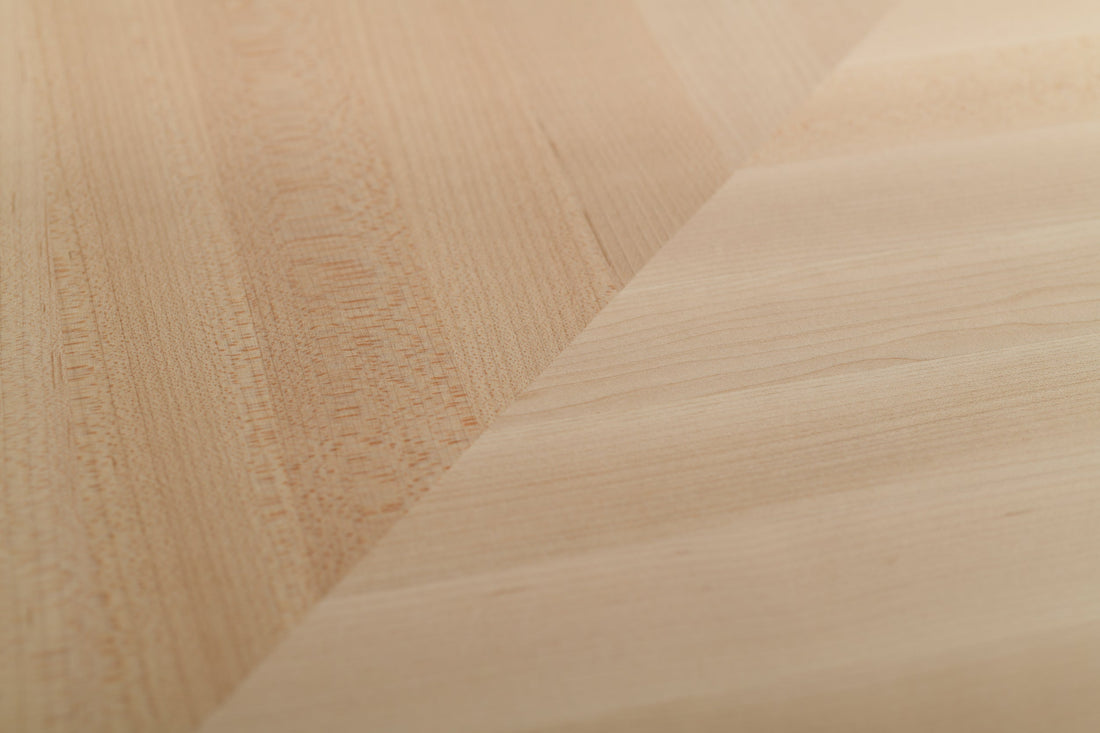What to know when choosing a countertop
The beauty of butcherblock countertop construction is that these countertops are durable enough to last a lifetime. Their timeless appeal can also harmonize with evolving styles and trends over the years. By making a sound investment now, you won’t have to worry about upgrading your countertops if you decide to do another remodel later!
What is wood grain?

We’ve all seen wood grain, whether or not we have thought about it. Maybe it was a kitchen table in grandma’s house, the floor in the school gym, or the counter at your favorite coffee shop - wood grain is present in products we use every day. But what IS wood grain, and why is it important when choosing a countertop?
Natural wood is just millions of wood fibers packed together within a tree's bark. These fibers are hollow tubes that carry water and nutrients between the roots of the tree and its leaves. In some trees, these fibers are very straight and rigid - like a metal pipe. In other trees, the fibers are soft and bendable like a piece of string. The grain pattern is how these fibers are packed together within the tree. The grain pattern's direction in relation to the working surface of the countertop is called grain orientation.
Grain orientation is critical when choosing your countertop because it directly affects its durability and appearance. There are three main construction methods when talking about products made from wood, each with a different grain orientation: end grain construction, edge grain construction, and face grain construction.
Face GrainFace grain is a broad grain pattern with lots of variation - similar to what you see on cupboard doors and kitchen tables. Many people feel that face grain construction produces the most beautiful wood pieces since fewer pieces of wood are used, and the grain patterns are more natural.

Face grain construction uses boards about 4” to 6” wide that are glued together edge-to-edge, with the face grain used as the working surface. While this is a great way to highlight the natural beauty of the wood, it is not the best choice if you need to do a lot of cutting or chopping. While face grain butcherblock is a better option than granite or other hard surfaces for cutting, cutting across the wood grain will still dull your knife over time. In addition, cutting marks are more visible than either edge grain or end grain construction, making face grain the least recommended of the three butcherblock construction types.
Edge GrainBecause of wood's nature, a board's edge grain is considered the strongest of the three wood grain patterns. This very robust pattern is one of the reasons why this grain orientation is widely  popular. The edge grain pattern of the wood is much different from the face grain pattern but is still very beautiful when built by skilled craftsmen. A well-made edge grain countertop can tie an entire kitchen together when made by craftsmen who take the time to hand-select and arrange each piece of wood.
popular. The edge grain pattern of the wood is much different from the face grain pattern but is still very beautiful when built by skilled craftsmen. A well-made edge grain countertop can tie an entire kitchen together when made by craftsmen who take the time to hand-select and arrange each piece of wood.
Visualize edge grain butcherblock by taking the same boards used in face grain construction, turning them on their edge, and then gluing them face-to-face. By doing this, the edge grain becomes the working surface of the butcherblock instead of the face grain.
If you made a countertop this way, it wouldn’t be very practical OR economical - it would be very thick and heavy, and you would have to use a lot more wood! For these reasons, the wider face grain boards are cut lengthwise into strips around 1.5” wide. We then rotate each strip so that the edge grain faces up and glue the strips together face-to-face.
Cutting on an edge grain surface will still leave cut marks, but not nearly as many as on face grain surfaces. Light to medium cut marks can be removed with a bit of sanding and re-oiling IF you finish your top with a natural Tung Oil finish.

End grain is the top (or bottom) cross-section of the thousands of individual wood fibers. When you are counting the rings of a tree to see how old it is, you are looking at the end grain. You often see end grain butcherblock used to make cutting boards with geometric patterns using different wood species.  However, it doesn’t have to be used just for designs - single species end grain countertops can be the perfect option for many kitchens, from a 200-year-old farmhouse remodel to new home construction.
However, it doesn’t have to be used just for designs - single species end grain countertops can be the perfect option for many kitchens, from a 200-year-old farmhouse remodel to new home construction.
To continue the visualization example above, imagine taking the strips of wood used in edge grain construction, standing them on their ends, and gluing them together. The top of this behemoth - the working surface - would be end grain butcherblock. However, this butcher block would be anywhere from 4 feet to 16 feet tall, depending on the length of the strips you were using! Instead of dealing with that, the strips used in edge grain construction are cut into short pieces about 1.5” long, so each piece ends up being a cube. These cubes are glued together with the end grain forming the working surface.
End grain construction is the strongest of the three types of butcherblock construction, and it is also considered the best surface to use for cutting and chopping because it is the easiest on knife edges and hides the knife marks quite well. When cutting food items on end grain butcherblock, the knife blade "slides through" the wood fibers instead of cutting them. Not only does this minimize the dulling of the knife blade, but it also allows the wood fibers to snap back into position and hide most of the cutting marks.
Which grain orientation is the best choice for your kitchen?
That’s the beauty of choosing a butcherblock countertop - there is no correct answer! The best choice depends on how you envision using your countertop over the years.
These days, kitchens are often the hub of the house - cooking, eating, homework, remote work, etc. A hard maple edge grain countertop will provide a natural warmth to any kitchen while giving you a durable, multi-use surface that can last for generations.
We recommend hard maple face grain construction for kitchens designed more for casual entertaining rather than everyday use. The broader boards showcase the natural beauty created by Mother Nature, and the hard surface is still durable enough for most day-to-day cooking tasks. If you need to do any cutting or chopping, add a beautifully crafted maple end grain butcherblock cutting board to your kitchen arsenal.
We recommend hard maple end grain construction if you plan on training for the next Iron Chef competition. Not only will this protect your knives with all the cutting and chopping, but it will also hide most of the cutting marks.
Regardless of the construction type, you can’t go wrong with a well-crafted butcherblock countertop.


